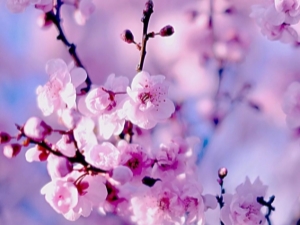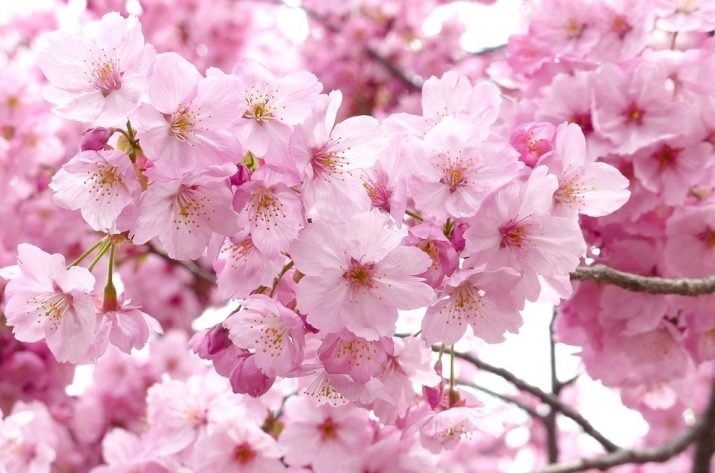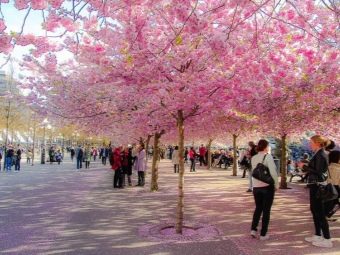Sakura: what is it and where is growing?

Sakura is considered one of the most beautiful trees, and therefore it is often used to decorate landscape design.Despite the fact that Japan is the birthplace of this culture, you can meet it in Korea, Western Europe, North America and even in Russia and Ukraine. Many Japanese consulates are decorated with this unusual plant, which makes it possible to associate it with this beautiful country.
What is it and where is growing?
Sakura belongs to the Pink family and is actually a decorative cherry. Under natural conditions, a tree can reach 20 meters in height, but usually its height does not exceed 8 meters. You can find it on the smooth bark, which is covered with horizontal cracks of gray-green color and jagged oval leaves.
The main distinctive feature of Sakura is bright flowers, having a white or pink shade. But you can find yellow, red and green flowers. There are many different types of Japanese cherry, and therefore among them there are varieties with inflorescences, which consist of 5, 10 and 40 petals. Breeders were able to bring trees whose flowers look like peonies and chrysanthemums.
The fruits of this culture have a rounded shape and bright red color. They differ in a large bone and a small amount of pulp, besides cherries have a sour taste. In their raw form they are not consumed, but used to make marinade or wine.
Japanese cherry is considered a symbol of Japan, as it grows mainly on the fertile plains of this country. According to the flowering of the culture, the Japanese determine the time of sowing of rice, and therefore it is associated among residents with well-being and fertility. Due to the unusual appearance of the plant, many great people sought inspiration while admiring the flowering of the sakura.
Sakura grows mainly in Japan, the Korean Peninsula and in some areas of China. You can meet her in the mountainous areas of Sakhalin or the forests of Primorsky Krai. Japanese cherry is not able to withstand great frosts, and therefore almost does not occur in Russia. Only thanks to the work of breeders, some varieties can grow in the northern regions of our country.
Varieties
There are more than 400 varieties of sakura. Most of the species is used only for decorating the site, but some can bear fruit. Known variety that is able to bring edible cherries.
Distinguish melkopilchatuyu, ferruginous, Sakhalin and short bristling sakura.
- Ferrous cherry found in China, Korea and Primorsky Krai. The tree grows up to 1.5 meters in height and is used exclusively for decorative purposes. It is quite unpretentious, and therefore is in great demand among summer residents. Some types of ferrous cherries produce edible fruits that can be used in cooking.
- Melkopilchataya Sakura different tall and large leaves. In the autumn period, the crown acquires a bright pink and purple color. This plant blooms with large white and pink flowers, forming inflorescences 15-20 cm in diameter.
- Short bristle cherry does not differ in big height and on average grows to 8-10 m. The plant blossoms with light pink flowers, forming inflorescences with a diameter of 2.5 cm.
- Sakhalin Sakura differs sprawling crown and grows above 8 m. The culture is distinguished by bright red leaves, which in the autumn period acquire a rich burgundy shade.
Most varieties belong to the serrate form. Initially, there were only 4 varieties of sakura, from which the breeders subsequently derived many others.
Consider the description of the most popular varieties.
- Kanzan - is the result of crossing melkopilchataya sakura and decorative plums. The variety is home to Japan, but it can be found in Korea and China. The shrub grows no higher than 11 m in height and has a trunk diameter of 5.5 m. The wide crown is represented by elliptical green leaves, which become orange in autumn."Kanzan" blooms in mid-spring with double pink flowers, and in the summer it brings harvest in the form of small black cherries that have a bitter taste.
- "Kiku Shidar" - low-growing shrub, whose height does not exceed 6 meters. The crown is represented by large elliptical leaves of green color. At the onset of autumn, they become yellow. The culture in the middle of spring blossoms with pink dense inflorescences consisting of 3-5 flowers. "Kiku Shidar" is not afraid of frost and can tolerate lowering the temperature to 30 degrees. The variety is resistant to diseases and usually grows on moist subacid soils.
- Royal Burgundy - grows up to 10 m in height and is distinguished by a cone-shaped crown. The pointed leaves of a variety have a bright purple hue; in autumn they turn yellow. The plant blooms at the beginning of May with large double flowers of soft pink shade. The fruits of "Royal Burgundy" does not bring.
- "Gum" - is a distant relative of the sea buckthorn and is distinguished by small red cherries that can be eaten. The fruits have a sweet-sour taste and are rich in vitamins, therefore they are often used for making compotes and preserves. The plant itself has a height of 1 m and blooms gray-yellow flowers, exuding a pleasant aroma.
In addition to these varieties, such species as “Fuy-Dzakura”, “Yama-Dzakura”, “Someioshino”, “Yae-Dzakura” and “Kasumi-Dzakura” are very popular. All of them differ in a form and a shade of flowers and leaves, and also have different height.
Flowering time
Japanese cherry blossoms at different times, depending on the variety. For example, in January, one can observe the flowering of sakura on the island of Okinawa, and in early April, shrubs on the island of Hokkaido are covered with flowers. Residents of Japan are preparing for this event in advance, organizing a special celebration in honor of this.
Hanami is a traditional festival held in the center of Tokyo with famous people. In early April, people admire the flowering trees, settling on the bedding under the spreading crowns. The event lasts only a few days, as the warm weather contributes to the accelerated flowering of sakura.
Annually, Japanese cherry blossoms at different times. It depends on the weather, and therefore the warmer it is on the street, the sooner the flowers bloom. There are even special people who predict the timing of cherry blossoms.
The optimum temperature for flowering shrubs is + 18 ° C, and therefore in Russia, this cherry blooms not earlier than May.
What is different from cherry or apple?
Despite the fact that Sakura belongs to the family of Pink, it has some differences from the cherry. The main feature of the culture is that, unlike the usual cherry, it is designed to decorate landscape design. Most varieties of sakura differ in abundant flowering, but do not bear fruit.
Varieties of Japanese cherries, bearing fruits, have a large bone and a bitter taste. Only some hybrids can produce a crop that can be eaten. Such trees are called sakurambo. In this case, the Japanese use as food not only cherries, but also leaves and flowers.
Cherry and apple are very similar during the flowering period, so some people may confuse these two cultures with each other. But the flowering of sakura is different with double pink flowers, forming dense inflorescences. Ornamental apple varieties may have a purple, blood red or white color of the inflorescences, which consist of more rare flowers. They bring beautiful fruits, differing in small size and sour-tart taste.
Some facts
- The Japanese are anxious about sakura, considering it the main property of the country. Often it is used as an inspiration for creating paintings, writing songs and poems, as well as for sketching tattoos.
- There is a legend according to which the Sun Goddess wanted to marry her grandson with one of the daughters of God Horus.The young man could choose as his wife a daughter, who was called High Rock, or a girl called Blossoming. If he chose the High Rock, his family life would be characterized by durability and strength, but the young man chose Blossom and doomed his descendants to a wonderful, but short fate. Another legend says that Sakura was called by a certain Japanese man who, together with his family, was forced to work for the miserly and cruel prince. Tired of hard life, Sakura turned to the emperor for help. But thanks to the scammers, the prince found out about this and ordered his subordinates to tie the worker and his family to a cherry tree and kill them. That is why every year Sakura blooms with pink flowers, symbolizing the blood of the innocent victims.
- It is also interesting that the Japanese associate the flowering of sakura with the transience of days. In their opinion, it is this incredible sight that should remind people of the fragility of everything beautiful and the cyclical nature of life.
- Japanese cherry is a symbol of Japanese soldiers. Often, it was used by military pilots as a talisman, who believed that after death they would be reborn as flowers.
- In the Japanese city of Hotuko grows sakura, which, according to legend, is more than 2 thousand years old. The tree is considered a national treasure and due to its respectable age it has the name “Sakura of the Age of Gods”.
You will learn about how the sakura grows in the middle lane in the next video.




































